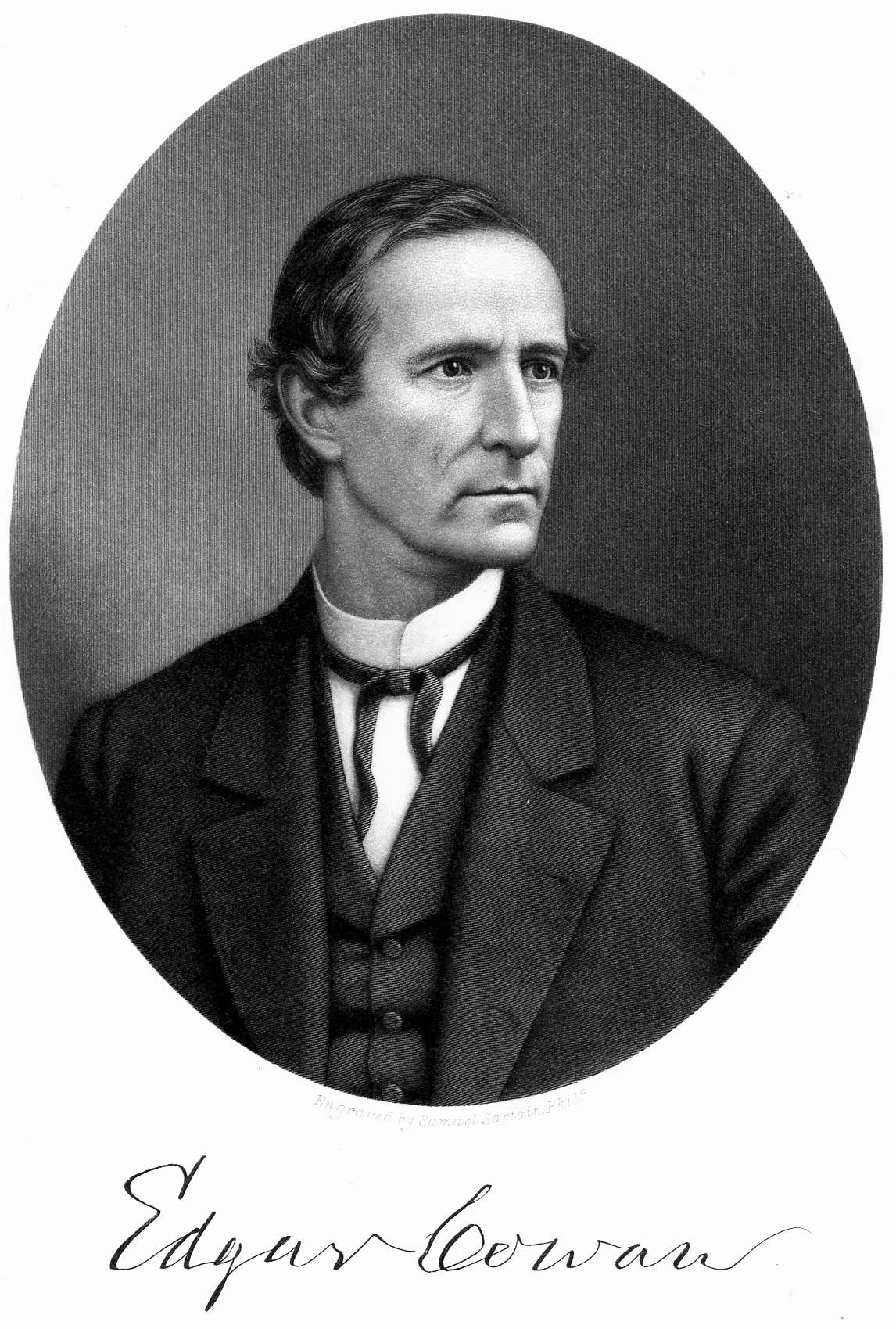Husband Edgar Cowan, LL.D. 1

Born: 19 Sep 1815 - Sewickley Twp, Westmoreland Co, PA 1
Christened:
Died: 31 Aug 1885 2
Buried: - St. Clair Cemetery, Greensburg, Westmoreland Co, PA
Father: [Unk] Cowan ( - )
Mother:
Marriage: 1842 2
• Biographical Sketch: George Dallas Albert, History of the County of Westmoreland, Pennsylvania (Philadelphia, PA: L. H. Everts & Co., 1882).
To read this biographical sketch of his life and career, click here.
Wife Lucy Oliver 2
Born:
Christened:
Died:
Buried:
Father: Col. James B. Oliver (Abt 1780-1873) 2
Mother:
Children
1 F Elizabeth "Lizzie" Cowan 2 3
Born:
Christened:
Died:
Buried:
Spouse: James Jack Hazlett ( -Bef 1918) 2 3 4
2 M Dr. Frank Cowan 2
Born:
Christened:
Died:
Buried:
3 M James B. O. Cowan 2
Born: 2 Oct 1846 - Greensburg, Westmoreland Co, PA 2
Christened:
Died:
Buried:
General Notes: Husband - Edgar Cowan, LL.D.
His mother may have been Willianna Cowan, daughter of his grandfather, Capt. William Cowan; [BHCWC, 92] states this. If true, we might assume that he was born out of wedlock since he had his mother's surname and was raised in his maternal grandfather's family.
In the family of his grandfather he passed the early years of his childhood. Senator Cowan owed nothing to birth or fortune to fit him for his distinguished career in after-life, but he had an unquenchable thirst for knowledge, and during boyhood read every book he could obtain. At sixteen years of age he went to Allegheny County, PA, where he taught school for six months, then engaged for a time in rough carpenter work, help build the West Newton bridge and ran a keel-boat, whereby he earned a little money and entered Greensburg academy. Completing the academy course, he taught several terms of school, and in 1838 entered Franklin college, Ohio, from which he graduated in 1839, as valedictorian of his class. In 1871 his alma mater conferred upon him the degree of L.L.D.
He read law with Hon. Henry D. Foster, and was admitted to the Westmoreland county bar in February, 1842. He opened an office at Greensburg, where his commanding talents and superior legal attainments soon secured him a large and lucrative practice. He was always employed in the most important cases which came before the courts, and was generally successful in the suits he brought or defended, although often opposed by the best legal talent of the State. In 1855 he made a most masterly defense of Ward and Gibson, who were indicted for murder, and by his consummate skill, great eloquence, and extensive knowledge of criminal law secured an acquittal, where nothing but conviction was expected and demanded by the public. In the succeeding year he prosecuted Corigan for murder and secured a verdict for conviction, although the prisoner was ably and stubbornly defended by Hon. Henry D. Foster and Col. Samuel Black, of Pittsburg.
Specially qualified by natural ability and well fitted by a classical education and a thorough knowledge of constitutional law for political leadership, he soon became conspicuous as a speaker at political meetings in his own county. He was originally a Jackson democrat but joined the whigs in 1840, and in 1856 supported “Fremont in preference to Fillmore and Buchanan, the former of whom represented know-nothing-ism, and the latter indifferentism to the extension of slavery into the territories.” In 1860, on account of the Kansas troubles, he united with the conservative republicans and was elector on the Lincoln and Hamlin ticket. In January, 1861, Edgar Cowan was elected to the United States Senate, taking his seat on the fourth of March, 1861. In view of the war he laid down for his own guidance five rules from which he never swerved:
1. That the North should not violate the constitution in coercing the South.
2. That there were two elements to be conciliated; the Democratic party in the Free States, and the Union men of the Border and Confederate States.
3. That Congress should confine itself to providing sufficient revenue and raising armies.
4. That the war should be waged according to the rules of civilized warfare.
5. That the war was made to suppress a rebellion and not to make a conquest of the Confederate States. In pursuance of these rules he spoke and voted against legal tender, confiscation, national banks, tenure of office, reconstruction, Freedmen’s Bureau and civil rights. He also opposed test oaths and negro suffrage. He was the author of the $300 clause in the conscription act, and by having the Steubenville bridge raised prevented the destruction of the lumber and coal trade of western Pennsylvania on the Ohio river.
When elected to the senate he was unknown except in south-western Pennsylvania, but he was soon recognized at Washington city as a leading lawyer, a fine classical scholar, and as fully abreast in science and philosophy with the best thought of the time. His speeches were earnest, eloquent and logical, and he was soon known throughout the land as one of the intellectual giants of the United States senate. In describing Mr. Cowan, the poet, N. P. Willis, said: “Of his powerfully proportioned frame and finely-chiseled features, the Senator seemed as naturally unconscious as of his singular readiness and universal erudition.” He well maintained the prestige and honor of Pennsylvania and the press throughout the Union during his senatorial career spoke in the highest terms of him as a man of great ability, wonderful eloquence, earnest conviction and noble independence. When his senatorial term ended in 1867, he returned to Greensburg and was engaged for several years in the practice of his profession. [BHCWC, 68]
For the last ten years of his his life he was nearly blind and his constant companion was his son, James, doing nearly all his reading, writing and office work.